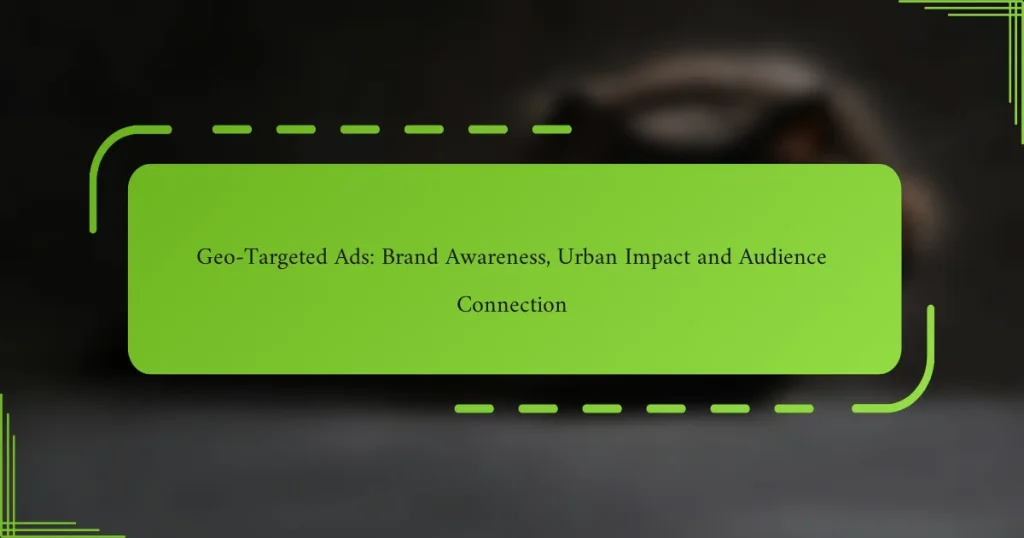Geo-targeted ads are a powerful tool for businesses in Georgia, allowing them to connect with local audiences through tailored messaging. By focusing on specific geographic locations, these ads enhance marketing effectiveness, improve customer engagement, and optimize advertising costs, ultimately leading to higher conversion rates.
Geo-Targeted გასაშვებები: Brand Awareness, Urban Impact and Audience Connection
_geo-Targeted Ads_: პერსონალიზაცია, მომხმარებლის გამოცდილება და ჩართულობა
Geo-Targeted რეკლამები: ROI, ღირებულების ეფექტურობა და გაყიდვების ზრდა
Geo-Targeted Ads: გრძელი ვადის სარგებელი, गैरაღორძინებადი გავლენა და საზოგადოებრივი ჩართვა
Geo-Targeted რეკლამები: Case Studies, Success Metrics and Hospitality Insights
Geo-Targeted Ads vs. ტრადიციული რეკლამა: რომელი არის უკეთესი და როდის უნდა გამოიყენოთ
How do geo-targeted ads improve marketing effectiveness in Georgia?
Geo-targeted ads enhance marketing effectiveness in Georgia by delivering tailored messages to specific local audiences. This approach ensures that advertisements resonate with the cultural and regional preferences of consumers, leading to better engagement and conversion outcomes.
Increased relevance to local audiences
Geo-targeted ads allow businesses to craft messages that align with the interests and needs of local consumers in Georgia. For example, a restaurant in Tbilisi can promote a special dish that reflects local cuisine, making the ad more appealing to residents. This localized approach increases the likelihood that potential customers will respond positively.
By focusing on local events, traditions, or promotions, businesses can create a stronger connection with their audience, fostering brand loyalty and community engagement.
Higher engagement rates
Ads that are relevant to local audiences typically see higher engagement rates. When consumers feel that an advertisement speaks directly to them, they are more likely to interact with it. For instance, a clothing store in Batumi might highlight seasonal sales that cater to the local climate, prompting more clicks and shares on social media.
Utilizing geo-targeting can also help businesses time their ads effectively, reaching audiences when they are most likely to be receptive, such as during local festivals or holidays.
Improved conversion rates
Geo-targeted ads can significantly boost conversion rates by ensuring that the right message reaches the right audience at the right time. When consumers receive offers that are relevant to their location, they are more inclined to make a purchase. For example, a local service provider can offer discounts to nearby residents, increasing the chances of conversion.
To maximize conversion rates, businesses should analyze local consumer behavior and preferences, adjusting their strategies accordingly. This could involve A/B testing different messages or offers to see which resonates best with the target demographic in a specific area.
What are the key benefits of geo-targeted ads?
Geo-targeted ads provide businesses with the ability to reach specific audiences based on their geographic location, enhancing marketing effectiveness. This approach leads to improved customer engagement, optimized advertising costs, and a stronger competitive edge in local markets.
Enhanced customer experience
Geo-targeted ads create a more personalized experience for customers by delivering relevant content based on their location. For instance, a restaurant can promote local specials to users within a certain radius, making the ads more appealing and timely.
By tailoring messages to local preferences and cultural nuances, businesses can foster a deeper connection with their audience. This localized approach often results in higher engagement rates and customer satisfaction.
Cost efficiency in ad spend
Geo-targeted advertising can significantly reduce wasted ad spend by focusing resources on specific areas where potential customers are located. Instead of casting a wide net, businesses can concentrate their budgets on regions with higher conversion potential.
For example, a retailer may allocate a larger portion of their budget to urban areas with a higher population density, ensuring that their ads reach the most relevant audience. This strategic spending can lead to a better return on investment (ROI).
Better competition positioning
By utilizing geo-targeted ads, businesses can effectively position themselves against local competitors. Targeting specific demographics in defined areas allows companies to highlight their unique offerings and advantages over others in the same market.
For instance, a local service provider can emphasize their proximity and quick response times in ads, making them more attractive to nearby customers. This localized strategy helps businesses stand out and capture market share in competitive environments.
How can businesses in Georgia implement geo-targeted ads?
Businesses in Georgia can effectively implement geo-targeted ads by utilizing various digital marketing tools that focus on specific locations. This involves leveraging platforms like Google Ads and social media, as well as optimizing local SEO strategies to reach potential customers in their area.
Utilizing Google Ads location targeting
Google Ads offers robust location targeting options that allow businesses to show ads to users based on their geographic location. Companies can specify locations down to the city or even a radius around a specific address, ensuring that their ads reach the most relevant audience.
To implement this, businesses should set up their Google Ads account and choose the location settings that best match their target market. Regularly reviewing performance metrics can help refine these settings for better results.
Leveraging social media platforms like Facebook
Social media platforms, particularly Facebook, provide advanced targeting features that enable businesses to reach users based on their location. By creating location-specific ads, companies can engage local audiences effectively, promoting events, sales, or services tailored to their community.
Businesses should utilize Facebook’s audience insights to understand local demographics and interests, which can enhance ad relevance. Testing different ad formats and messages can also help identify what resonates best with local users.
Employing local SEO strategies
Local SEO is essential for businesses aiming to attract customers in specific geographic areas. By optimizing their website and online listings for local search terms, businesses can improve their visibility in search engine results when potential customers look for services nearby.
Key strategies include claiming and optimizing Google My Business listings, using local keywords in website content, and encouraging customer reviews. Regularly updating these elements can significantly enhance local search rankings and drive more traffic to the business.
What metrics should be tracked for geo-targeted ads?
To effectively measure the success of geo-targeted ads, focus on metrics that highlight performance variations across different locations. Key metrics include click-through rates, conversion rates, and customer engagement metrics, as they provide insights into how well ads resonate with local audiences.
Click-through rates by location
Click-through rates (CTR) indicate how often users click on your ads after seeing them. Tracking CTR by location helps identify which regions respond best to your campaigns. For instance, a CTR of 2-5% might be typical in urban areas, while rural regions may see lower rates.
To optimize CTR, consider tailoring your ad content to reflect local culture, language, and interests. A/B testing different messages can also reveal what resonates most with specific demographics.
Conversion rates from local campaigns
Conversion rates measure the percentage of users who complete a desired action, such as making a purchase or signing up for a newsletter. Monitoring conversion rates for local campaigns is crucial, as they can vary significantly based on location. A conversion rate of 5-10% is often seen as successful in many markets.
To enhance conversion rates, ensure that your landing pages are relevant to the local audience. Incorporating local testimonials or offers can increase trust and encourage action.
Customer engagement metrics
Customer engagement metrics, such as time spent on site and interaction rates, provide insight into how users from different locations interact with your content. High engagement often correlates with better conversion rates. Aim for users to spend at least a few minutes on your site to foster deeper connections.
To boost engagement, create localized content that speaks directly to the interests and needs of your target audience. Utilizing local events or trends in your advertising can significantly enhance user interaction.
What are the challenges of geo-targeted advertising?
Geo-targeted advertising presents several challenges that marketers must navigate to achieve effective campaigns. These challenges include data privacy concerns, potential for over-segmentation, and technical implementation hurdles that can complicate ad delivery.
Data privacy concerns
With increasing regulations around data protection, such as GDPR in Europe, advertisers must be cautious about how they collect and use location data. Consumers are becoming more aware of their privacy rights, leading to a reluctance to share personal information. Marketers should prioritize transparency and obtain explicit consent when gathering location data.
To mitigate privacy issues, consider using anonymized data or aggregated insights rather than individual tracking. This approach can help maintain user trust while still allowing for effective targeting.
Potential for over-segmentation
Geo-targeted ads can lead to over-segmentation, where audiences are divided into too many small groups. This can dilute the effectiveness of campaigns and make it challenging to reach a sufficient number of potential customers. Striking a balance between targeted messaging and broader reach is essential.
Marketers should focus on key geographic areas that align with their business goals rather than trying to target every possible segment. Testing different audience sizes can help identify the optimal approach for maximizing engagement.
Technical implementation hurdles
Implementing geo-targeted advertising often involves complex technical setups, including integration with various platforms and tools. Advertisers need to ensure that their systems can accurately track and serve ads based on users’ locations. This may require significant investment in technology and expertise.
To overcome these hurdles, consider partnering with experienced vendors who specialize in geo-targeting solutions. Additionally, regularly testing and optimizing your campaigns can help identify and resolve technical issues early on.
How does geo-targeting compare to traditional advertising methods?
Geo-targeting offers a more precise approach than traditional advertising by focusing on specific locations, allowing businesses to reach their target audience more effectively. Unlike broad methods that cast a wide net, geo-targeted ads deliver relevant content based on the user’s geographic location, enhancing engagement and conversion rates.
Increased Relevance
Geo-targeted ads provide content that is tailored to the local audience, making it more relevant and appealing. For example, a restaurant can promote a special dish to nearby customers, while a retail store can advertise a sale on seasonal items. This localized approach often results in higher click-through rates and improved customer satisfaction.
Cost Efficiency
By focusing on specific regions, businesses can allocate their advertising budget more effectively. Geo-targeting minimizes waste by ensuring that ads are only shown to users in relevant areas, which can lead to a better return on investment. For instance, a local service provider can avoid spending on ads shown to users outside their service area.
Enhanced Analytics
Geo-targeting allows for more detailed analytics, enabling businesses to track the performance of their ads based on location. This data can reveal which regions are responding best to campaigns, allowing for adjustments to be made in real-time. Companies can use this information to refine their strategies and focus on high-performing areas.
Competitive Advantage
Utilizing geo-targeted ads can provide a significant edge over competitors who rely on traditional advertising methods. By reaching potential customers with tailored messages, businesses can establish a stronger connection and foster brand loyalty. This targeted approach can be particularly beneficial in crowded markets where standing out is crucial.






